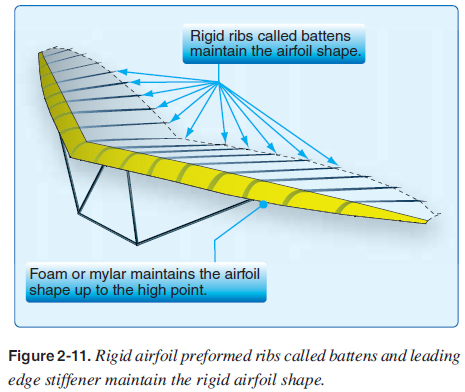
 |
|
||
CHAPTER 2. Aerodynamics WSC Wing Flexibility The WSC wing retains its rigid airfoil shape due to rigid preformed ribs called battens, which are inserted from the root to the tip along the span of the wing (similar to ribs for an airplane wing) and a piece of foam or mylar running along the top side of the leading edge to the high point, which maintains its front part of the airfoil shape in between the battens. [Figure 2-11]  Some WSC double surface wing designs use a rib similar to a PPC wing that attaches to the lower surface and the upper surface to maintain the wing camber in addition to the battens. Even though the airfoil sections are rigid, the WSC aircraft is called a “ fl ex wing” for two reasons. First, it is designed so the outboard leading edges fl ex up and back when loaded. The fl exing of the outboard section of the wing also allows load relief because the tips increase twist and decrease AOA—the greater the weight, the greater the fl ex and wing twist. This fl exing allows the WSC aircraft to automatically reduce loads in unstable air, providing a smoother ride than a rigid wing. Since the wing fl exes and reduces the load for a given angle of attack at the root chord, WSC aircraft cannot obtain loads as high as those obtained by a rigid wing. This fl exing of the outboard leading edges also assists in initiating a turn. Second, the wing is designed to fl ex as it changes twist from side to side for turning, historically known as wing warping. WSC wing warping is similar to what the Wright Brothers did on their early aircraft, but they did it with wires warping the wing. The WSC aircraft uses no wires and warps the wing by shifting the weight, which is covered in Chapter 3, Components and Systems. This fl exibility is designed into the wing primarily for turning the aircraft without any movable control surfaces like the ailerons and rudder on an airplane. |
| ©AvStop Online Magazine Contact Us Return To Books |